Much has been made of the simulation in Monster Hunter Wilds during the beta-filled run-up to its release. The ecosystem is teeming with beetles, fish and geckos. Seasons change. Carnivores go out hunting herbivores, and the herbivores wander around in a way that would make Sam Neill sit down in shock and exclaim that they really do move in herds. But those impressive details haven’t had much impact on how I play this beast-whacking action game, or any effect on how my brain operates in the midst of a thoughtless crafting splurge. Pare back the vigorwasps and rockslides and sizzling steaks and what you find is a loot-the-loop straight out of an MMO, complemented with chunky combat that remains satisfying to those with the acquired taste for it and overwrought to those who crave simplicity.
For many, it’s exactly what you’d expect and want of Monster Hunter. But if the buzz of bashing beasts for stat-bumps quickly wanes for you, the final hours of its 20-25 hour campaign will pass with diminishing interest. When Monster Hunter Wilds finally lets go of your hand and says “okay, go do your own thing!” I felt like handing in my notice to the guild. I’ve seen enough of this monster to know that it’s beautiful, swole, and not for me.
You play as an expedition leader heading out into the “Forbidden Lands”. There’s talk of a giant and fearsome beast terrorising this uncharted region (isn’t there always?) and you’re going to map the place, make contact with local tribes, and design snakeskin shoes out of all the native wildlife. If you’ve never played a Monster Hunter game, you’re in for a long and patchy tutorial of a story mode, not to mention lots of googling things like “best ammo for killing monkey” or “how to dismiss annoying cat”.
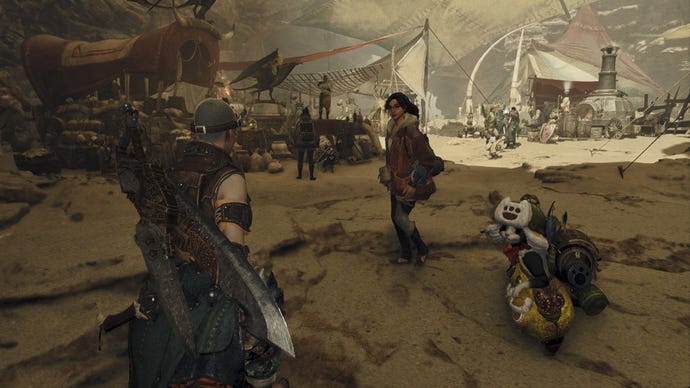
In short, it is a loot-likers action game of steadily killing your way up a ladder of better helmets and fiercer greatswords, while learning the weaknesses and attack patterns of giant foes who roam forest floors and icy caverns. Monster Hunter games can feel like playthings of preparation, resolve, and reward. They can also be a festival of grind.
Wilds is no different, and is especially similar to Monster Hunter: World, with a few eye-catching changes. There are returning beasts like the Rathalos (classic hard-headed dragon), the Yian Kut-Ku (frilly idiot), and the Congalala (large farting baboon). But also new wretches like the horrendously drippy oil octopus Nu Udra, who likes to let loose with all tentacles at once, and a fleshy-mouthed sandworm called the Balahara, which can turn dunes into quicksand that swallows you up.
If there’s something I can’t fault, it’s that bestiary. The animals are varied, violent, and hideous in all the right ways. As in previous instalments, they sometimes encounter each other while roaming and get into a fight – ten times more fun to watch than to interrupt. Seeing an Ajarakan (spicy lava gorilla) get hobbled by the aforementioned giant cephalopod made of crude oil is as delightful as whomping the simian geezer yourself.
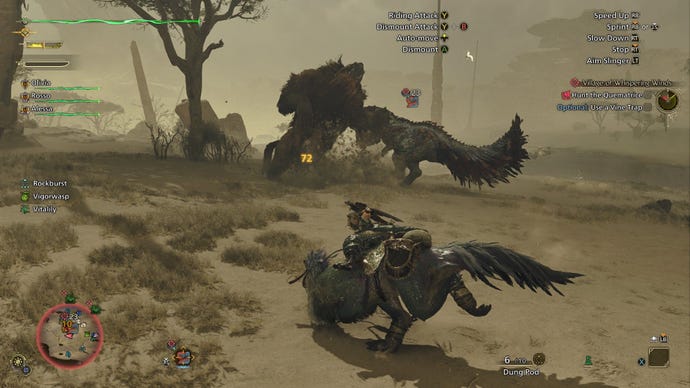
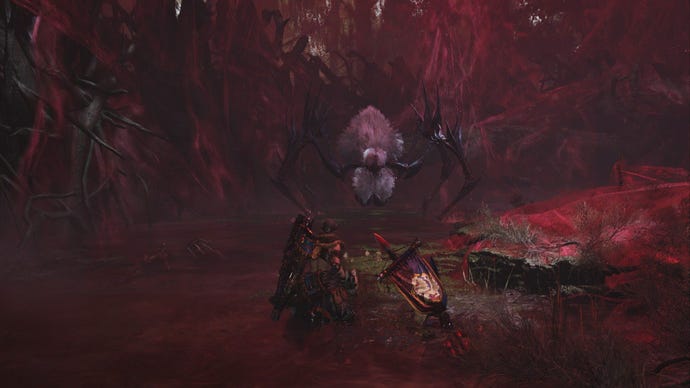
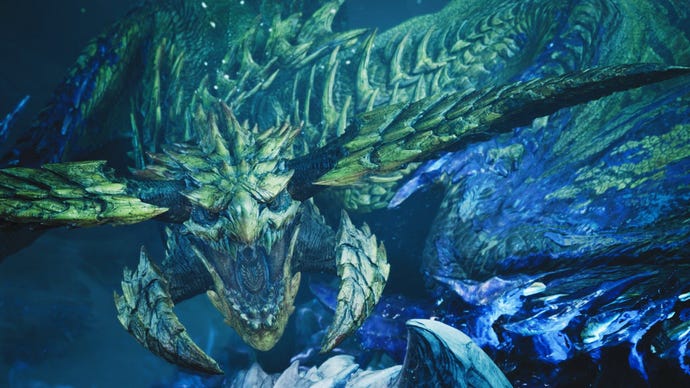
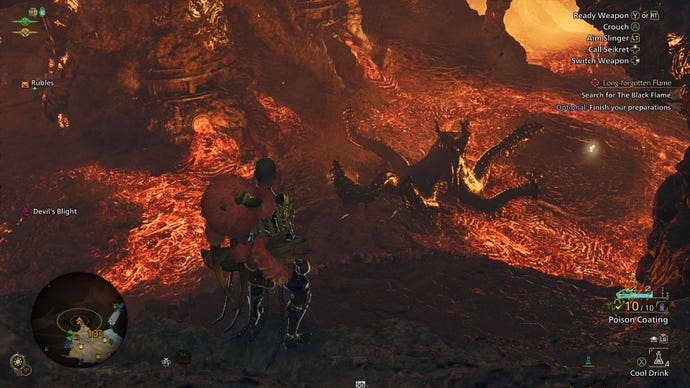
But that commitment to animality is a given with these games. The new bits and bobs are what matters. The world has become seamless, and the different zones (desert plains, lush rainforest, frigid caverns, etc) now lead directly to one another sans loading screens. Each zone has two major seasons that dictate the type and frequency of animals, alongside an “inclemency” period. These are hazardous sandstorms or downpours during which lightning might strike the ground at random, and will provide you a chance to catch ‘n’ kill certain beasts who only show up in these rough-weather moments.
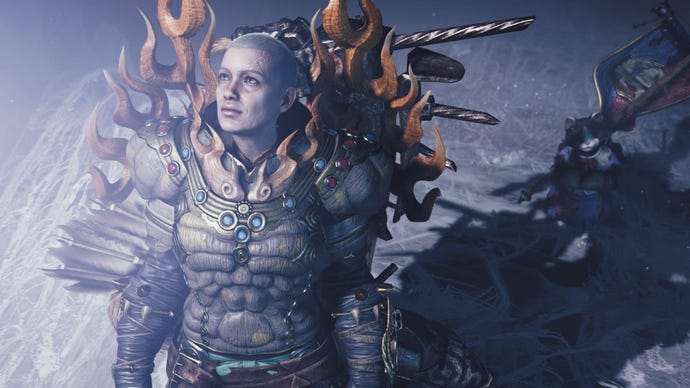
When it comes to weapons, the developers haven’t added anything new. Which doesn’t bother me – there are still more weapons to learn than time to learn them. I stuck with the trusty bow for ranged murder, and dipped into mashy-slashy twin blades once in a while (I also vaulted into the air with the insect glaive during a beta, as a treat). There is, again, a satisfaction to learning the exact way each weapon is intended to be used. But combat is not without its esoterica.
Every Monster Hunter I play sees me relearning the necessary clutter of radial dials and shortcut combos to survive a tail swipe. I’ve never considered fighting in these games “fluid”. Instead they lean into a kind of panicked mid-fight item management that sees you slash a few times, back off, sharpen your weapon, slash a few times, roll away, take a potion, slash a few times, call your bird pal, change slinger ammo, eat a piece of beef, slug a forest pepsi, attack again…
That fighty bitey rhythm is here much the same as ever. You’re wearing something down over a protracted and often scrappy brawl. The mishmash of controls plays into that, your finger on the shortcut bumper acting as a mental backpack you’ve got to continually open and root around within, looking among twenty possible options for the one barrel or trap or piece of bait you need. It feels like rummaging through your mum’s messy purse for the single pound coin she needs for the toll booth that is swiftly approaching.
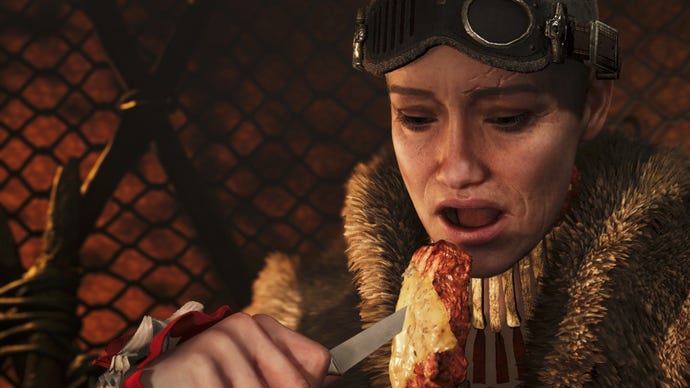
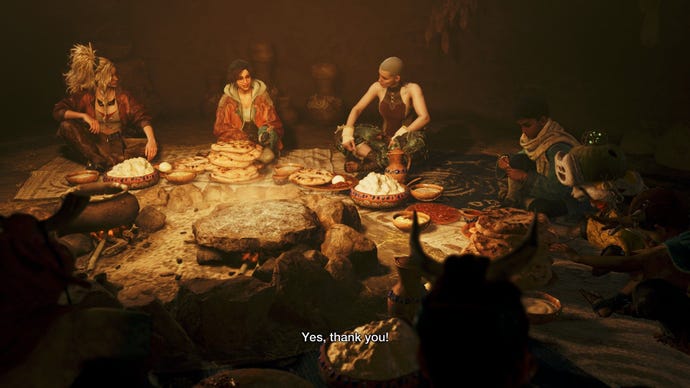
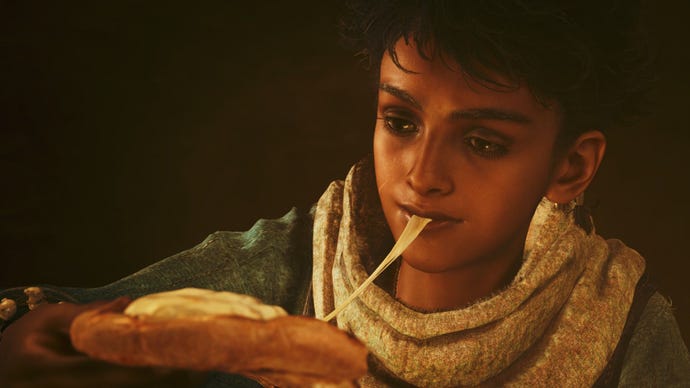
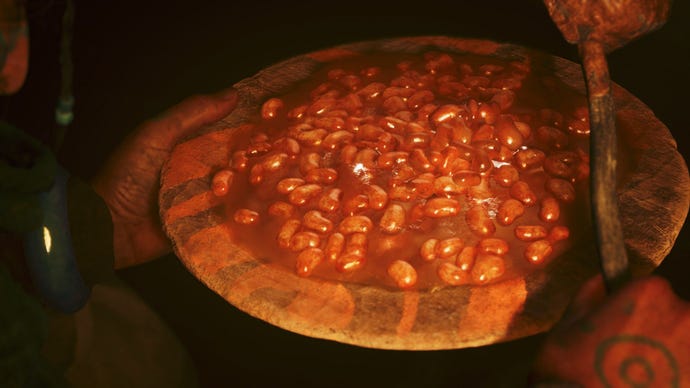
Having your fingers full of fight or flight feels appropriate, but it also sometimes annoys me purely from a hands-on-buttons perspective. I often like combat to be graceful and streamlined in games, and I hold the radial menu itself to be a crutch that too many shooters and action adventures rely on because they’re afraid to meaningfully limit the player’s choices in the field. Wilds is similarly afraid to pigeonhole you. There are 14 different weapons. There are 25 slots in your item bag. There are a-number-I-do-not-know of gizmos to use mid-battle. Piercing pods, barrel bombs, shock traps, ghillie suits, throwing knives, poison clouds… It wants you to be a versatile and adaptable hunter, and as usual this comes at the expense of having a clean and uncomplicated control scheme. Who needs elegance of interface when you have 16 types of bowgun ammo to cycle through?
That complexity and variety can make it intimidating. I’m not exactly a newcomer, having dossed about in Monster Hunter: World and briefly toyed with its expansion, Iceborne. But even with that background Wilds is hefty with unexplained elements. Or else things are explained only at a glance, relevant tutorials are put off until hours into the game, or sometimes buried in the help menus. Your galumphing for guides will continue apace. “Why arrows infinite but gun ammo not?” you type into Bing, sweating. “How to blow bubbles good”, you hammer into Ask Jeeves, feverish for aid.
Wilds isn’t a forthcoming game, and I don’t necessarily fault the developers for this. It’s tough to build an on-ramp for a game this granular without slowing down the missions greatly. But I don’t think the solution is to deliver essential bits of knowledge via small text boxes in the urgent heat of battle – you can’t exactly ask the Doshaguma (grizzly mole rat) for a second to read the tool tips. Again, if this is your first foray into hunterising monstrosities, you can either view Wilds’ unintuitive first steps as evidence of richness and intricacy, or as a confusing clutter of combat ideas thrown into a single action game. One of these opinions will reward you with 60 hours of dopamine, the other will reward you with 60 hours of your life back.
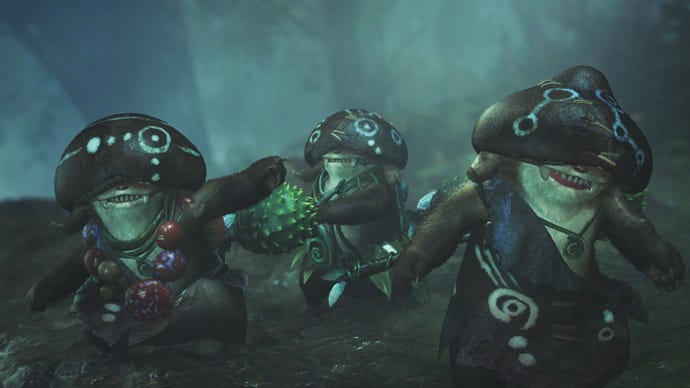
This timesinkiness is intentional, of course. It encourages you to be an efficiency hound, crafting the perfect set of fire-resistant armour for a particularly spicy beast. The most upgradified stamina-boosting talisman, the fullest purse of cooling drinks. If you’re still having trouble you can set off the handy SOS flare to call on co-op randos who’ll help you bully whatever borkosaurus you have in sight. Pre-release I only had a rare couple of encounters with other folk, so I can’t say how significantly that co-op cuts down the grind. Judging by previous games, it’ll shorten things while also making fights more flailing and chaotic.
In any case, battles can also be approached with reckless brute force. Just make sure your weapon’s damage number is big enough, and hit the right bits of wing, tail, and buttock. For all its talk of prep and strategy, I have found much of Wilds doable without engaging with elemental min-maxing or specific weaponry (although you do eventually run up against an icy difficulty spike or two). This makes it both approachable to new players but also a blunter game than many fans often boast of the series.
If the bristlesome combat hasn’t changed dramatically, then navigating the world has. The biggest change in real terms is the Seikret, a dinosaur you ride around like an extinct motorbike with a beak. It helpfully lets you carry two weapons on a hunt – one on your back and one holstered on your saddle, which you can retrieve just by whistling for the battlebirb to come pick you up. You can also shoot arrows and slingshot ammo while galloping about, or dip into your feathery friend’s backup bag of potions and traps. All appropriately hunty behaviour.
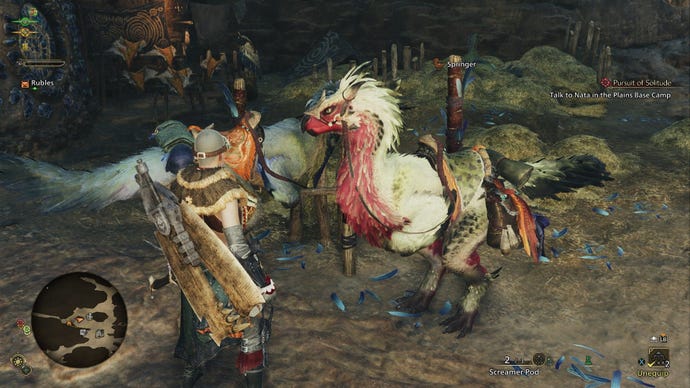
This toothy mount is a great-looking creature and an interesting additive to combat, but also an emblem of the overbearing control that Capcom’s game designers want to exert during the game’s story. Your dinoride will frequently autojog in the direction of the next waypoint. You can steer it left or right to some extent (sharing control might be appropriate for a horseosaurus with scent glands and a mind of its own) but lots of story quests will see you riding slowly on lizardback with no say over direction, chatting with your companions as if this were Red Dead Redemption 2 and not a game about battering large frogs. It repeatedly engages in the always-annoying trend of slowing you down to a crawl, or stopping you from going any other direction but the preordained path, riding around on your Chocofaux for long periods with your hands fighting to understand when they’ll get a chance to take over from the auto-playing game.
I understand these story missions act as “wow” moments and are part of a longer tutorialising campaign intended to both dazzle and teach simultaneously. But I’ve never liked the control-wresting solution many blockbuster games use to approach this style of “on-boarding”. Especially if it takes the reins from your hands as often as this does. The developers recommended players take their time playing through it, a sentiment I generally agree with (even if I rarely get to be so indulgent as a reviewer) but Wilds’ desire to make sure you walk through the world slowly can become as draconian as the tyrant lizards you fight.
Not that navigating the world is overly thoughtful. For all its grandeur and beauty, you are rarely required to engage with the layout of these maps in a meaningful way. Your Seikret auto-drives you between waypoints, and open roaming between regions is rendered less significant when you mostly fast travel between them. There’s no orienteering or pathfinding necessary – the game is not designed with exploration in mind, but offers landscape as a spectacle. Beautiful vistas that you dash through on your way to kill another Lala Barina (spider in a tutu). For me that means that each environment lacks a sense of life. Not endemic life – there’s lots of that to pick up, capture, fish, harvest – but a life of the geography itself. You aren’t in conversation with the landscape of Wilds in the same way as you are in Breath Of The Wild or Shadow Of The Colossus. You won’t wonder how to reach a certain plateau or canyon floor. You move around the land with a job in mind and armour on the brain. You let Dino from The Flintstones take you home.
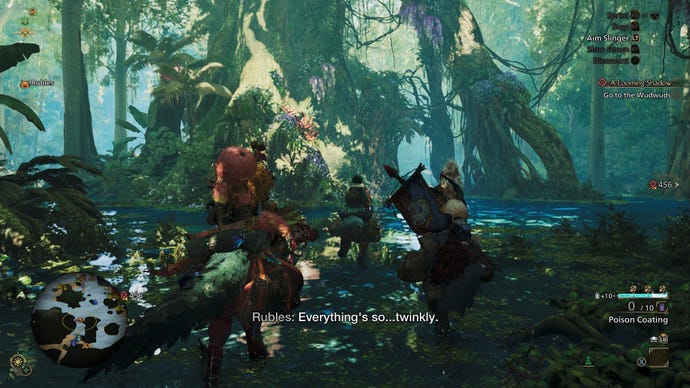
The campaign’s hand-holding eases off once the credits roll and you’re at your leisure to hunt, kill, or capture whatever beasts you fancy. Seasonal changes finally become significant and high-level environments offer new monster types to chase, along with a huge selection of new axes, swords, bowguns, and the rest – the tech trees unspool like tapestries. For fans this is likely a delectable moment, the cracking open of an easter egg full of goodies, if only you can face down the rabid scorpions inside. For me, it was more like being offered an easter egg when I had already been instructed to eat twenty chocolate bars in strict succession. Please, not another entire Toblerone. The roof of my mouth is fully perforated.
Wilds is once again a game of hunger and hunting, self-providing, and grinding your nights away against the whetstone of loot. Therein lies both the appeal and danger of Monster Hunter games. They are stuffed with compelling completionist catnip, yet wrapped in a philosophy of busywork. You are killing a very cool monster to get better gloves so you can kill another cool monster for more gloves. I mean, yes, that is video games writ large. And it keeps me sustained on the hamster wheel for a while. I too desire a fashionable suit for my intolerable cat.
But the motivation always sinks away before I hit the endgame. There is a place for loot-chasing games of endless hunger. And I find Wilds more involving as a voluntary submission to grind than the smooth-brained Destiny 2 or (ugh) Borderlands. A Monster Hunter game ought to be weighty, a land of friction and preparation. And I note the longstanding commitment to making sure a player must hit a monster in precisely the same way at least a hundred times before they make any visible progress (what is the melee equivalent of a “bullet sponge”?). But there are only so many guild contracts I can take before I clock off for the weekend.











Add comment